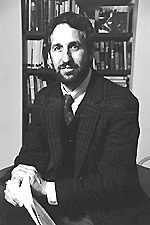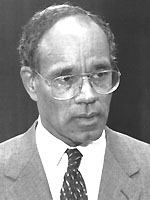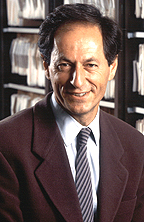
| T H E N I H C A T A L Y S T | J A N U A R Y – F E B R U A R Y 2001 |
|
|
|
CC Department of Clinical Bioethics Forum 'UNDERSTANDING
HEALTH DISPARITIES IN AMERICA'
|
|
Kidney transplantation is a medical issue: A doctor diagnoses a condition that warrants a kidney transplant; the patient gets on the transplant recipient waiting list; with luck, the patient outlives the wait, and the surgery happens. Race, gender, culture, and socioeconomic class have nothing to do with the process—except that in real life, they do.
 |
|
Arnold
Epstein
|
If you are African-American and have access to a certified clinical center that evaluates you for kidney transplant, and if you are then fortunate enough to be referred, the likelihood that you will receive a transplant is between 8.5 and 8.8 percent. The odds increase to 28–32 percent if you are white.
A rapidly expanding body of scientific and sociological research on health disparities is uncovering the fact that health care is not dispensed as impartially as one might expect. Last fall, the Department of Clinical Bioethics at the NIH Clinical Center provided a forum for the chorus of investigators at NIH and elsewhere who have been working to fulfill President Clinton’s 1998 mandate to reduce health disparities in the United States. A forum held October 25 explored the underpinnings of medical inequities, attempting to differentiate disparities in health outcomes and availability of health-care services, with particular focus on renal diseases, cancer, and heart disease.
The kidney transplant issue was addressed by Arnold Epstein, of the Harvard School of Public Health. Inequity in this arena, he said, is the result of a cascade of disparate evaluation practices, some very subtle, that biases access to transplant. Although doctors may attribute differences in treatment received by blacks and whites to "patient preferences," what data exist do not support that speculation. In fact, minorities receive less information, fewer referrals and spots on waiting lists, and more incomplete workups. "Once an incomplete workup is filed, if you are an African-American, you are again less likely to be referred and roughly four times less likely to receive a transplant," Epstein said.
"Overt discrimination is rare, but there is a pervasive pattern of whites getting more treatment than blacks. It is not an artifact of where people go to get treatment; it is an in-center effect," he noted. Another consequence of this differential treatment, however, is that whites are five times as likely to undergo inappropriate transplant procedures.
 |
|
Harold
Freeman
|
"Every cancer has racial disparities, that is a fact we all know," observed Harold Freeman, associate director for reducing health disparities at NCI and chairperson of the President’s Cancer Panel. He called race "the single most defining issue in the history of America" with significant repercussions in the realm of medical care. "But racial categories," he said, "were determined by racism. . . . and there is a need to disentangle the social meaning of race from biology."
Research has shown that African- American men have the highest incidence of cancer and the highest overall cancer mortality. Among women, African-Americans, Alaskan Natives, and whites have the highest cancer incidence, but African Americans and Alaskan Natives are more likely to die of the disease.
As a practitioner in Harlem, where 96 percent of his patients were black and 41 percent were poor, Freeman found that half of the African American women who presented with breast cancer were at stages that had gone beyond the reach of modern technology. "What is it," he asked, "that makes people come in so late, when the disease is incurable?"
Poverty and culture play heavy roles in cancer outcome. Survival is 10–15 percent lower among the poor. "There is a diminished access to health care, inadequate physical and social support systems, inadequate information, and riskier lifestyle, behavior, and attitudes." Culture, Freeman said, can modify the effects of poverty, as reflected in the social support systems found in poor Hispanic communities. And the nondrinking, nonsmoking culture of Seventh Day Adventists has been credited with that population’s six-year cancer survival advantage.
"The effects of poverty translate into 10 years of life expectancy (loss) and 20 years of difference in disease development," said James House, director of the University of Michigan Survey Research Center. "There is a terrible accumulation of disadvantage across generations, but one can transcend early disadvantage and stop the process," he maintained, citing Social Security as an example of one program that has had a huge effect on health and mortality in older populations. He also credited the Civil Rights Movement with helping to narrow disparities, decrease infant mortality, and increase life expectancy overall.
 |
|
Norman
Anderson
|
Health Is Where the Home Is
Norman Anderson, the first director of the NIH Office of Behavioral and Social Sciences Research and now at the Harvard School of Public Health, arranged the causes of health disparities into three interactive categories requiring three different levels of analysis: social and environmental factors; behavioral and psychological factors; and biological pathways.
He, too, focused on the socioeconomic effectors of health. He cited William Wilson’s "The Truly Disadvantaged," a study of residential segregation in Chicago and its effect on mortality. Published in 1987, the study showed that poor blacks—but not poor whites—overwhelmingly resided in neighborhoods where the majority of their neighbors were poor. Whites were more integrated with regard to socioeconomic status in housing, a finding with substantial health consequences because predominantly poor neighborhoods "were associated with all types of factors, all causes, that increase mortality; regardless of individual status (even if of higher income)." Anderson referenced another recent housing study that showed that realtors offered fewer rental units and housing options to blacks and more credit and favorable terms to whites when purchasing or renting homes.
Job Perquisites
 |
|
Michael
Marmot
|
Michael Marmot’s landmark "Whitehall Studies" followed the health of British civil servants of all grades over many years and found a correlation between longevity and health and one’s grade of employment. "Nonsmoking British administrators are nearly immortal, and that may account for some of our present problems," quipped Marmot, of University College, London.
The Whitehall II studies, begun in 1985, found that degree of control in one’s job correlated inversely with disease risk. Low job control, for example, carried a 2.5-fold increase in coronary heart disease risk. Jobs with low effort and high reward were found to confer less disease risk than jobs with high effort and low reward.
Some studies suggest that money isn’t everything; others, that it makes quite a difference. One of the former compared three nations with equivalent gross national product—South Africa, Hungary, and Costa Rica—and found that Costa Rica had half the infant mortality rate and at least seven more years of life expectancy than the other two. A money-is-the-root-of-disparities finding in another study showed that increased risk of later behavioral and cardiovascular problems in babies with low birth weight was ameliorated in those born to wealthier households.
And what at first glance
in another British study appeared to be a pitfall of single-mom households compared
with natural-parent or reconstituted two-parent households—a higher risk
of behavioral problems in the children—on closer inspection turned out
to revolve around economic status. This, Marmot noted, is a particularly interesting
finding in a country with a national health system. Social and economic factors—independent
of health care access, which is universal in England—play a major role
in health disparities. Indeed, 37 of 39 recommendations to address health disparities
in the 1998 Acheson
Report did not relate to health services (which are a given) but to such
social programs as bus service for the elderly and tax adjustments for women
and children. ![]()
|
TO UNDO THE PAST |
|
"There are plenty of studies documenting that people are treated differently based on the color of their skin—and their gender—and that these treatment disparities exist regardless of socioeconomic status," Stephen Thomas, director of the Center for Minority Health at the University of Pittsburgh Graduate School of Public Health, asserted at a seminar on eliminating health disparities, held last fall by the Office of Disease Prevention. "Breast cancer is more common in white women, but more likely to kill black women," he continued. "It is now cheaper to transplant a kidney than it is to do dialysis, but you will find more African-Americans on dialysis. Why is that? Why no donors? If you ask an African-American, that individual will say, ‘I don’t want to be teetering on life in an emergency room [and have someone take my organs]. If I sign that card, my organs will be more important than my life’." Hesitation among minorities to seek medical help or participate in clinical research can be explained by one word—"Tuskegee"—a word that summons to mind differential treatment and a history of abuse, Thomas observed. "Anytime you are dealing with a vulnerable population, that is when issues of trust, justice, and race must be examined as factors. . . . ‘Breakthroughs’ in research mean nothing if they cannot be translated into improving the quality of life of the people who pay for the trials. We look for proof of institutional change," Thomas said, citing as a hopeful example at NIH the June 2000 appointment by NCI of Harold Freeman (see above) as associate director for reducing health disparities. Freeman is the president, chief executive officer, and director of surgery at New York’s North General Hospital. He was also the director of surgery at Harlem Hospital from 1974 to 1979. —M.C. |